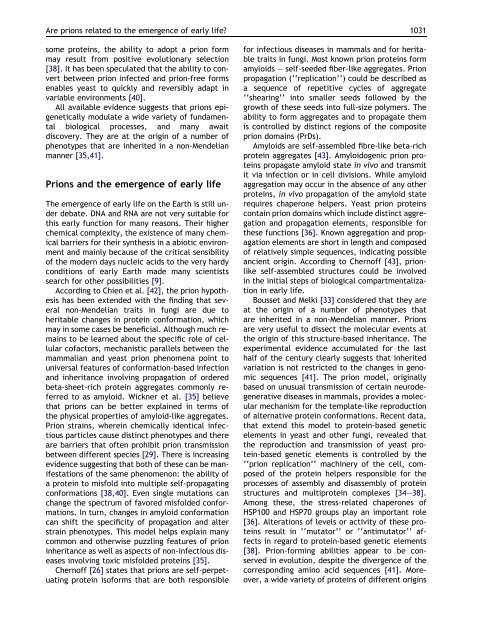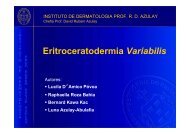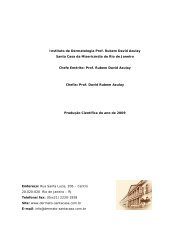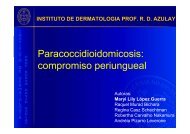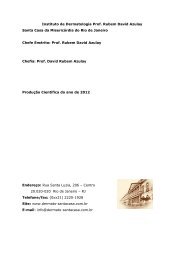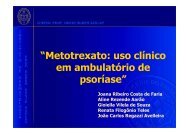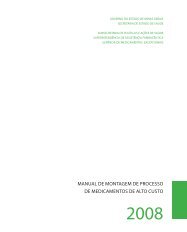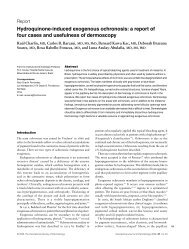Are prions related to the emergence of early life? - instituto de ...
Are prions related to the emergence of early life? - instituto de ...
Are prions related to the emergence of early life? - instituto de ...
You also want an ePaper? Increase the reach of your titles
YUMPU automatically turns print PDFs into web optimized ePapers that Google loves.
<strong>Are</strong> <strong>prions</strong> <strong>related</strong> <strong>to</strong> <strong>the</strong> <strong>emergence</strong> <strong>of</strong> <strong>early</strong> <strong>life</strong>? 1031<br />
some proteins, <strong>the</strong> ability <strong>to</strong> adopt a prion form<br />
may result from positive evolutionary selection<br />
[38]. It has been speculated that <strong>the</strong> ability <strong>to</strong> convert<br />
between prion infected and prion-free forms<br />
enables yeast <strong>to</strong> quickly and reversibly adapt in<br />
variable environments [40].<br />
All available evi<strong>de</strong>nce suggests that <strong>prions</strong> epigenetically<br />
modulate a wi<strong>de</strong> variety <strong>of</strong> fundamental<br />
biological processes, and many await<br />
discovery. They are at <strong>the</strong> origin <strong>of</strong> a number <strong>of</strong><br />
phenotypes that are inherited in a non-Men<strong>de</strong>lian<br />
manner [35,41].<br />
Prions and <strong>the</strong> <strong>emergence</strong> <strong>of</strong> <strong>early</strong> <strong>life</strong><br />
The <strong>emergence</strong> <strong>of</strong> <strong>early</strong> <strong>life</strong> on <strong>the</strong> Earth is still un<strong>de</strong>r<br />
<strong>de</strong>bate. DNA and RNA are not very suitable for<br />
this <strong>early</strong> function for many reasons. Their higher<br />
chemical complexity, <strong>the</strong> existence <strong>of</strong> many chemical<br />
barriers for <strong>the</strong>ir syn<strong>the</strong>sis in a abiotic environment<br />
and mainly because <strong>of</strong> <strong>the</strong> critical sensibility<br />
<strong>of</strong> <strong>the</strong> mo<strong>de</strong>rn days nucleic acids <strong>to</strong> <strong>the</strong> very hardy<br />
conditions <strong>of</strong> <strong>early</strong> Earth ma<strong>de</strong> many scientists<br />
search for o<strong>the</strong>r possibilities [9].<br />
According <strong>to</strong> Chien et al. [42], <strong>the</strong> prion hypo<strong>the</strong>sis<br />
has been exten<strong>de</strong>d with <strong>the</strong> finding that several<br />
non-Men<strong>de</strong>lian traits in fungi are due <strong>to</strong><br />
heritable changes in protein conformation, which<br />
may in some cases be beneficial. Although much remains<br />
<strong>to</strong> be learned about <strong>the</strong> specific role <strong>of</strong> cellular<br />
c<strong>of</strong>ac<strong>to</strong>rs, mechanistic parallels between <strong>the</strong><br />
mammalian and yeast prion phenomena point <strong>to</strong><br />
universal features <strong>of</strong> conformation-based infection<br />
and inheritance involving propagation <strong>of</strong> or<strong>de</strong>red<br />
beta-sheet-rich protein aggregates commonly referred<br />
<strong>to</strong> as amyloid. Wickner et al. [35] believe<br />
that <strong>prions</strong> can be better explained in terms <strong>of</strong><br />
<strong>the</strong> physical properties <strong>of</strong> amyloid-like aggregates.<br />
Prion strains, wherein chemically i<strong>de</strong>ntical infectious<br />
particles cause distinct phenotypes and <strong>the</strong>re<br />
are barriers that <strong>of</strong>ten prohibit prion transmission<br />
between different species [29]. There is increasing<br />
evi<strong>de</strong>nce suggesting that both <strong>of</strong> <strong>the</strong>se can be manifestations<br />
<strong>of</strong> <strong>the</strong> same phenomenon: <strong>the</strong> ability <strong>of</strong><br />
a protein <strong>to</strong> misfold in<strong>to</strong> multiple self-propagating<br />
conformations [38,40]. Even single mutations can<br />
change <strong>the</strong> spectrum <strong>of</strong> favored misfol<strong>de</strong>d conformations.<br />
In turn, changes in amyloid conformation<br />
can shift <strong>the</strong> specificity <strong>of</strong> propagation and alter<br />
strain phenotypes. This mo<strong>de</strong>l helps explain many<br />
common and o<strong>the</strong>rwise puzzling features <strong>of</strong> prion<br />
inheritance as well as aspects <strong>of</strong> non-infectious diseases<br />
involving <strong>to</strong>xic misfol<strong>de</strong>d proteins [35].<br />
Chern<strong>of</strong>f [26] states that <strong>prions</strong> are self-perpetuating<br />
protein is<strong>of</strong>orms that are both responsible<br />
for infectious diseases in mammals and for heritable<br />
traits in fungi. Most known prion proteins form<br />
amyloids – self-see<strong>de</strong>d fiber-like aggregates. Prion<br />
propagation (‘‘replication’’) could be <strong>de</strong>scribed as<br />
a sequence <strong>of</strong> repetitive cycles <strong>of</strong> aggregate<br />
‘‘shearing’’ in<strong>to</strong> smaller seeds followed by <strong>the</strong><br />
growth <strong>of</strong> <strong>the</strong>se seeds in<strong>to</strong> full-size polymers. The<br />
ability <strong>to</strong> form aggregates and <strong>to</strong> propagate <strong>the</strong>m<br />
is controlled by distinct regions <strong>of</strong> <strong>the</strong> composite<br />
prion domains (PrDs).<br />
Amyloids are self-assembled fibre-like beta-rich<br />
protein aggregates [43]. Amyloidogenic prion proteins<br />
propagate amyloid state in vivo and transmit<br />
it via infection or in cell divisions. While amyloid<br />
aggregation may occur in <strong>the</strong> absence <strong>of</strong> any o<strong>the</strong>r<br />
proteins, in vivo propagation <strong>of</strong> <strong>the</strong> amyloid state<br />
requires chaperone helpers. Yeast prion proteins<br />
contain prion domains which inclu<strong>de</strong> distinct aggregation<br />
and propagation elements, responsible for<br />
<strong>the</strong>se functions [36]. Known aggregation and propagation<br />
elements are short in length and composed<br />
<strong>of</strong> relatively simple sequences, indicating possible<br />
ancient origin. According <strong>to</strong> Chern<strong>of</strong>f [43], prionlike<br />
self-assembled structures could be involved<br />
in <strong>the</strong> initial steps <strong>of</strong> biological compartmentalization<br />
in <strong>early</strong> <strong>life</strong>.<br />
Bousset and Melki [33] consi<strong>de</strong>red that <strong>the</strong>y are<br />
at <strong>the</strong> origin <strong>of</strong> a number <strong>of</strong> phenotypes that<br />
are inherited in a non-Men<strong>de</strong>lian manner. Prions<br />
are very useful <strong>to</strong> dissect <strong>the</strong> molecular events at<br />
<strong>the</strong> origin <strong>of</strong> this structure-based inheritance. The<br />
experimental evi<strong>de</strong>nce accumulated for <strong>the</strong> last<br />
half <strong>of</strong> <strong>the</strong> century cl<strong>early</strong> suggests that inherited<br />
variation is not restricted <strong>to</strong> <strong>the</strong> changes in genomic<br />
sequences [41]. The prion mo<strong>de</strong>l, originally<br />
based on unusual transmission <strong>of</strong> certain neuro<strong>de</strong>generative<br />
diseases in mammals, provi<strong>de</strong>s a molecular<br />
mechanism for <strong>the</strong> template-like reproduction<br />
<strong>of</strong> alternative protein conformations. Recent data,<br />
that extend this mo<strong>de</strong>l <strong>to</strong> protein-based genetic<br />
elements in yeast and o<strong>the</strong>r fungi, revealed that<br />
<strong>the</strong> reproduction and transmission <strong>of</strong> yeast protein-based<br />
genetic elements is controlled by <strong>the</strong><br />
‘‘prion replication’’ machinery <strong>of</strong> <strong>the</strong> cell, composed<br />
<strong>of</strong> <strong>the</strong> protein helpers responsible for <strong>the</strong><br />
processes <strong>of</strong> assembly and disassembly <strong>of</strong> protein<br />
structures and multiprotein complexes [34–38].<br />
Among <strong>the</strong>se, <strong>the</strong> stress-<strong>related</strong> chaperones <strong>of</strong><br />
HSP100 and HSP70 groups play an important role<br />
[36]. Alterations <strong>of</strong> levels or activity <strong>of</strong> <strong>the</strong>se proteins<br />
result in ‘‘muta<strong>to</strong>r’’ or ‘‘antimuta<strong>to</strong>r’’ affects<br />
in regard <strong>to</strong> protein-based genetic elements<br />
[38]. Prion-forming abilities appear <strong>to</strong> be conserved<br />
in evolution, <strong>de</strong>spite <strong>the</strong> divergence <strong>of</strong> <strong>the</strong><br />
corresponding amino acid sequences [41]. Moreover,<br />
a wi<strong>de</strong> variety <strong>of</strong> proteins <strong>of</strong> different origins


